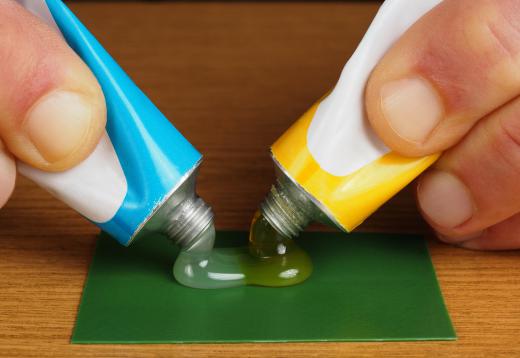Epoxy is a very useful thermosetting polymer that is often used as a long-lasting, durable adhesive and sealant. The epoxy mixing process can be a delicate one, so some things that will help it be most effective are precise measuring of the components; using a paper, metal or polyethylene container; and working in an environment that is neither too hot nor too cold. It is also important for one to use care when handling the chemicals involved in epoxy mixing, because they can be toxic.
The most important aspects working with epoxy are even mixing and using accurate proportions of the components. Epoxy should be mixed until it has an even consistency throughout — pockets of unmixed resin or hardener will not cure properly and will weaken the join. Also, epoxy mixing is essentially a controlled chemical reaction, and if resin-hardener ratio is not correct, the epoxy might not cure properly or might be very difficult to handle. To make sure that the amounts of the resin and hardener are exact, it is a good idea for one to use a graduated container for measuring large quantities. If the container used for measuring is not the same one as will be used for mixing, it is important for one to scrape all of the hardener or resin out in order to maintain the correct proportions.

The type of container used for epoxy mixing will also affect curing — unwaxed paper, metal and polyethylene are good material choices, because they will not contaminate the epoxy mixture. Disposable paper and metal containers can be bought relatively cheaply or made from materials on hand, such as cardboard or aluminum foil. Conductive metals will help diffuse the heat released by the chemical reaction of the two components, slowing the curing and allowing for a longer working time with the epoxy. Polyethylene containers are suited for repeated use, because well-mixed epoxy won’t stick to them after curing. Glass, polystyrene foam and waxed paper products should not be used, because the heat from the reaction can release contaminants into the epoxy and melt or shatter them.
The reaction that cures the epoxy involves heat, so the temperature of the mixing environment should be controlled. Excessive heat will accelerate curing, and cold might prevent the epoxy from reacting correctly. For safety reasons, epoxy mixing should be done in a well-ventilated area so that the fumes can be easily dispersed. It also is advisable for one to wear eye protection and gloves, especially when working with large amounts that might splatter or spill.
